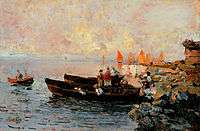Mosè Bianchi
Mosè Bianchi (Monza, 1840–1904) was an Italian painter and printmaker.
Biography
Bianchi's family moved from Monza to Milan and he enrolled at the Brera Academy. Having interrupted his studies to serve in the second war of independence, he returned to attend the school of painting directed by Giuseppe Bertini.
The award of a grant in 1867 enabled him to visit Venice and then Paris in 1869. He took part with some success at the Brera exhibitions and the Vienna Exhibition of 1873. It was in this period that he began to paint genre scenes in 18th-century settings and numerous portraits, soon becoming one of the artists most in demand with the Milanese middle classes. He returned to Venice in 1879 and visited Chioggia for the first time. Both places were to be featured also in later years in a series of intense views exhibited at exhibitions in Milan and Venice alongside genre scenes, views of Milan and landscapes of the countryside around Gignese.
Among his main works were a Monaca di Monza and a Milton exhibited in 1877 in Naples. In 1878, he exhibited in Paris a portrait of his father, a portrait of Signora Ponti, and I Chierici in Processione (Clerics in Procession). In 1881 in Milan, he exhibited: Burrasca nel Golfo di Venice; in 1884 in Turin, he exhibited : Canale di Chioggia; in 1887 Venice, he exhibited five canvases: Mascherata Chioggiotta; Laguna in burrasca; Chioggia ; Parola di Dio, and Vaporino di Chioggia.[1]
Art
 Vecchia Milano, Old Milano 1890
Vecchia Milano, Old Milano 1890 Woman in front of a Mirror c. 1900
Woman in front of a Mirror c. 1900- Carnaval in Venice c. 1910
 Flora, c. 1890
Flora, c. 1890 laguna-sul-tramonto
laguna-sul-tramonto Lavandaie sul Naviglio
Lavandaie sul Naviglio Portrait of a Lady, c. 1890
Portrait of a Lady, c. 1890 Paris place de Clichy 1884
Paris place de Clichy 1884
Works
- Gondola sul canale, oil on canvas, Carrara Academy, Bergamo.
- Una vittima del secolo XVII, 1863, Museo Civico, Brescia,
- Deposition, 1887 Cappella Visconti, Cimitère, Carnisio,
- The pittrice, 1974; Carrobbio, Museo Frugone, Nervi, Genoa,
- Frescoes, 1887 Villa Giovanelli, Lonigo,
- The sagra della vigilia, 1864; The lettrice, 1867; I fratelli al campo, 1867; The benedizione delle box, 1870 Interno rustico, Pinacoteca di Brera, Milan,
- Salotto Azzurro; Flora, 1885 Palazzo Turati, Milan,
- Deposition, 1899, Cimitero Monumentale, Cappella Frova, Milan
- Frescos, Saletta Reale, Stazione Centrale, Milan
- Cleopatra, 1865; Portrait of Orsola Rebecchi, 1875 Portrait of Luigi Galbiati, 1876; Traversata, 1885 Una nevicata a Milano, v.1885; Il ritorno dalla sagra, 1887; Pescatori has Chioggia, 1890; The Lavandaie 1894; Sad ritorno 1897; Notturno, v. 1898 Reminiscenze milanesi del 1848 1898 Busto di giovane donna, 1898 - 1899, Galleria d'Arte Moderna, Milan,
- Portrait of Giulia Lucini Colombani, 1894 Ospedale Maggiore, Milan
- Crucifixion, 1881 Diocesan Museum, Milan,
- Cavalcando; Pecore al ruscello; Scena rustic; Flora; Monache al lido; Donna col bambino al seno; Paolo and Francesca, Pinacoteca Ambrosiana, Milan
- Portrait of Giacinta Galimberti, 1861; Portrait of Simonetta Galimberti; 1861 Signora di Monza, 1865; Ritratto of uomo, 1875 The sorelle 1887, Museo Civico, Monza
- Una strada di Verona, Museo di Capodimonte, Naples
- Resurrection, 1874 Studio di testa, 1880; The paurose, 1881; Parola di Dio, 1887; Vaporino has Chioggia; Bosco nel Parco di Monza, 1895 Galleria Nazionale d'Arte Moderna, Rome,
- The comunione di S. Luigi Gonzaga, 1864 Church S. Maria Nascente and S. Carlo, Sant'Albino,
- It pittore Londonio, 1866; The lover Egidio, 1867; La Monaca di Monza, 1867 Galleria d'arte moderna, Turin
- The bufera, tempera on cardboard, Museo Revoltella, Trieste
- Crucifixion' (1879), parish church S. Antonio Abate, Valmadrera,
- Ritratto di signora v. 1898, Museo di Castelvecchio, Verona,
- Santuario della Beata Vergine dei Miracoli, Corbetta,
- Portrait of Simonetta Galimberti (1861)
- Portrait of Giacinta Galimberti (1861)
- Dopo il duello, (1866)
- In Monza Cathedral, (1872)
- Ritratto maschile, (1875)
- Portrait of Giuseppe Antonio Fossati (1875)
- La storia (1877)
- Stemma sabaudo it Genio di Savoia (1883-1884)
- The spesa del Curato, (1885)
See also
References
- Laura Casone, Mosè Bianchi, online catalogue Artgate by Fondazione Cariplo, 2010, CC BY-SA (source for the first revision of this article).
- ↑ Dizionario degli Artisti Italiani Viventi: pittori, scultori, e Architetti., by Angelo de Gubernatis. Tipe dei Successori Le Monnier, 1889, page 56-57.
Other projects
![]() Media related to Mosè Bianchi at Wikimedia Commons
Media related to Mosè Bianchi at Wikimedia Commons
